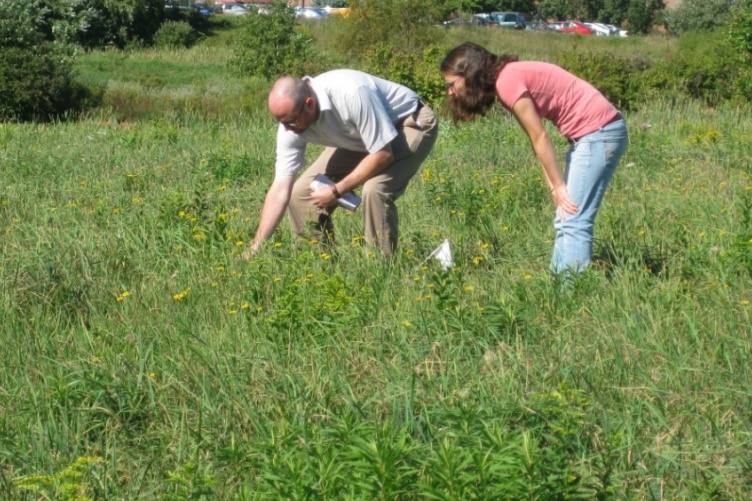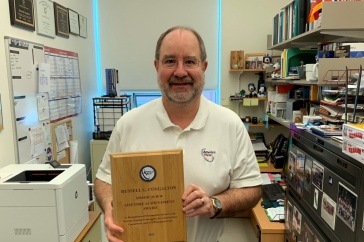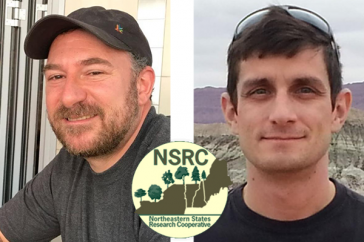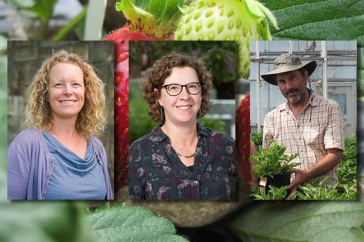
University of New Hampshire scientists have teamed up with the Strafford County Conservation District to test different combinations of cover crops, which farmers use for a number of reasons, including improving soil fertility and productivity, reducing erosion, and controlling pests.
The project under the direction of Richard Smith, assistant professor of agroecology, is funded by the NH Agricultural Experiment Station at the UNH College of Life Sciences and Agriculture.
“The conservation district is very excited about this project. The district is committed to helping local farms improve their soil health. Improvements in soil health can help the farms increase their productivity while reducing the sediment and nutrient runoff into the surrounding waterways,” said Vicky Stafford with the Strafford County Conservation District.
The project is underway on a one-acre hayfield on County Farm Road in Dover. It incorporates a variety of different approaches to inter-seeding a diverse mixture of cover crops without the use of tillage, a practice that can sometimes lead to soil erosion and reduced soil productivity. The cover crop mixture consists of a wide selection of annual, biennial, and perennial cover crops, including six different types of grass, five types of broadleaf plants, and four different types of legumes.
Each species in the mixture differs in terms of its growth requirements and the services it provides to the agroecosystem. Some of the species require a lot of water while others require less water. Some grow better in cool weather while others do better in warmer weather. Some species, such as the legumes, even provide their own nitrogen with the help of symbiotic microbes. The aim is to test all of the combinations of hayfield management and seeding – 64 plots total – to determine which approaches maximize the establishment of the cover crops and their beneficial effects on soil health and hayfield productivity.
Two of the conservation district’s pieces of farm equipment -- a no-till seeder and a soil aerator -- are being used in the research project. “We are very excited to demonstrate the effects of these pieces. The district is also very interested in providing information to farmers about the use of cover crops and the treatments surrounding the seeding, and ways to make cover cropping as effective as possible,” Stafford said.
The cover crop research also could have implications for native pollinators and integrated pest management, both areas of research that are currently being studied by NH Agricultural Experiment Station scientists.
Smith’s team, which includes Myers Shaiyen, a graduate student in the Department of Natural Resources and the Environment, plans to submit soil samples to the Cornell Soil Health Test annually to determine which cover crop treatments are meeting soil health objectives. They also will measure cover crop growth and hayfield productivity.
The project is part of a larger effort to develop more sustainable agricultural systems and support climate-smart agriculture.
“We are trying to figure out ways to practice agriculture sustainably. The conventional approach to increasing hayfield productivity would be to apply chemical fertilizers or manure, or to use tillage to establish the cover crops; however, these approaches would likely not improve soil health over the long term and could have unintended environmental impacts,” Smith said.
“So instead of relying on external inputs and tillage, we are testing strategies aimed at ‘ecological intensification,’ which involves using biotic interactions among species to drive improvement in fertility, productivity, and soil quality. Ideally, such an approach would not only improve productivity and soil health, but also other ecological services that underpin agricultural sustainability and human wellbeing,” he said.
Smith said the collaborative research project is ideal for the NH Agricultural Experiment Station. “We are taking several cover cropping approaches that appear to work well for grain crop farmers in the Midwest and Great Plains and trying to adapt them to a very different type of agricultural system common here in New Hampshire. This is risky. At this point, I would not be comfortable suggesting that farmers buy seed for a bunch of different cover crop species and try to sow them in their hayfield,” Smith said.
“But since our livelihood is not dependent on this hayfield, we can test these approaches and figure out what works and what needs improvement. Eventually, New Hampshire farmers will be able to visit these plots and decide for themselves what they might like to try on their own farms. By then, we’ll have figured out the pitfalls so farmers don’t have to absorb that risk,” he said.
Founded in 1887, the NH Agricultural Experiment Station at theUNH College of Life Sciences and Agriculture is UNH’s original research center and an elemental component of New Hampshire's land-grant university heritage and mission. We steward federal and state funding to provide unbiased and objective research concerning diverse aspects of sustainable agriculture and foods, aquaculture, forest management, and related wildlife, natural resources and rural community topics. We maintain the Woodman and Kingman agronomy and horticultural farms, the Macfarlane Greenhouses, the Fairchild Dairy Teaching and Research Center, and the Organic Dairy Research Farm. Additional properties also provide forage, forests and woodlands in direct support to research, teaching, and outreach.
-
Written By:
Lori Tyler Gula, PhD | NH Agricultural Experiment Station | lori.gula@unh.edu | 603-862-1452



















































